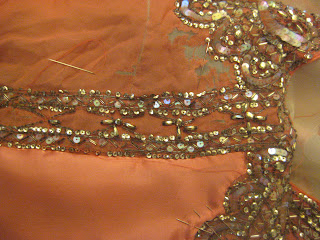 |
| Mark the Center Front and the buttonholes |
This is an easy method!
1. When you start a new sewing project, make the button holes first. It is easier to make the buttonholes on the individual piece instead of the finished garment.
2. It is important to use a light weight interfacing on the garment piece that will have buttonholes.
3. Carefully mark the Center Front and the buttonholes on the wrong side of the fabric.
I use a sharp pencil and parallel ruler to make sure the buttonholes are perpendicular to the center front.
4. Cut bias squares of fabric to create the lips of the buttonholes. Place this pieces on the right side of the fabric centered over the buttonholes that you have marked.
 |
| The bias square of self fabric measures 2" by 2" |
5. Now you need to sew the "box" for the buttonholes. You should use a slightly smaller stitch size. Sew slowly and carefully to create a even box. I often turn the wheel by hand at the corners to get perfect 90 degree angles at the corners. T counted three stitches on the short sides of the buttonholes so that they will all be the same.
6. Using very sharp scissors (so that you can cut into the corners but not cut the stitches that you have just sewn) cut open the rectangles but cutting the center of the buttonhole. Stop about 1/4" from each end.
 |
| Cut center of buttonhole open |
7. Then cut carefully into each corner of the buttonhole. Be especially careful to not cut the sewing thread.
 |
| Cut into each corner. Don't cut the stitching thread! |
8. Turn the bias pieces that you have sewn on the right side of the buttonholes inside to the wrong side.
9. Open up the bias piece of fabric on the wrong side and press the seam allowances of the button holes away from the buttonhole.
10. Next, carefully stitch the seam allowance on the narrow sides of the buttonholes to the bias piece of fabric. Be very careful that you don't sew it to the garment itself. I often make this mistake so look carefully at the photo so this step is completed correctly. This step makes the shorter sides of the finished buttonhole look neat and finished.
 |
| Note that you need to sew the seam allowance to the bias piece and not to the garment. |
|
|
|
11. Now add the cord to the lips to make corded bound buttonholes. Place the cord between the stitching line of the long side of the buttonholes and the bias piece. Roll the bias back over the cord to create the lip. Carefully pin in place so the width of the lips is even. Stitch by hand in the seam so that the stitch is hidden. This stitching technique is called "stitch in the ditch".
 |
| Place the cord next to the stitching line. |
|
 |
| Wrong side view of cording pinned in place. |
 |
| Pin the lips in place on right side being careful to keep lips even in width. |
 |
| Hand stitch the lips: "stitch in the ditch" to hide the stitch |
12. Tack the lips closed and then carefully press.
 |
| Tack the buttonhole closed for pressing. |
Next step will be finishing the back of the buttonholes!


































